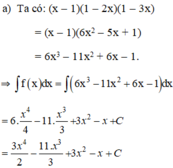
Những câu hỏi liên quan
Tìm các nguyên hàm sau:
a) \(\int (3x^2-2x-4)dx \)
b) \(\int(\sin3x-\cos4x)dx \)
c) \(\int(e^{-3x}-4^x)dx \)
d) \(\int\ln(x)dx \)
e) \(\int(x.e^x)dx \)
f) \(\int(x+1).\sin(x)dx \)
g) \(\int x.\ln(x)dx \)
\(\int\left(3x^2-2x-4\right)dx=x^3-x^2-4x+C\)
\(\int\left(sin3x-cos4x\right)dx=-\dfrac{1}{3}cos3x-\dfrac{1}{4}sin4x+C\)
\(\int\left(e^{-3x}-4^x\right)dx=-\dfrac{1}{3}e^{-3x}-\dfrac{4^x}{ln4}+C\)
d. \(I=\int lnxdx\)
Đặt \(\left\{{}\begin{matrix}u=lnx\\dv=dx\end{matrix}\right.\) \(\Rightarrow\left\{{}\begin{matrix}du=\dfrac{dx}{x}\\v=x\end{matrix}\right.\)
\(\Rightarrow u=x.lnx-\int dx=x.lnx-x+C\)
e. Đặt \(\left\{{}\begin{matrix}u=x\\dv=e^xdx\end{matrix}\right.\) \(\Rightarrow\left\{{}\begin{matrix}du=dx\\v=e^x\end{matrix}\right.\)
\(\Rightarrow I=x.e^x-\int e^xdx=x.e^x-e^x+C\)
f.
Đặt \(\left\{{}\begin{matrix}u=x+1\\dv=sinxdx\end{matrix}\right.\) \(\Rightarrow\left\{{}\begin{matrix}du=dx\\v=-cosx\end{matrix}\right.\)
\(\Rightarrow I=-\left(x+1\right)cosx+\int cosxdx=-\left(x+1\right)cosx+sinx+C\)
g.
Đặt \(\left\{{}\begin{matrix}u=lnx\\dv=xdx\end{matrix}\right.\) \(\Rightarrow\left\{{}\begin{matrix}du=\dfrac{dx}{x}\\v=\dfrac{1}{2}x^2\end{matrix}\right.\)
\(\Rightarrow I=\dfrac{1}{2}x^2.lnx-\dfrac{1}{2}\int xdx=\dfrac{1}{2}x^2.lnx-\dfrac{1}{4}x^2+C\)
Đúng 2
Bình luận (0)
Tìm nguyên hàm của các hàm số sau:
f(x) = (x-1)(1-2x)(1-3x)
Bải 1: Tìm tập xác định của các hàm số
sau:
a)
3x-2
2x+1
c) y=\sqrt{2x+1}-\sqrt{3-x}
b) y=
²+2x-3
d) y=
√2x+1
X
f(x)
Chú ý: * Hàm số cho dạng v
thi f(x) * 0.
ở Hàm số cho dạng y = v/(x) thì f(r) 2 0.
X
* Hàm số cho dạng " J7(p) thi f(x)>0.
a: TXĐ: \(D=R\backslash\left\{-\dfrac{1}{2}\right\}\)
b: TXĐ: \(D=R\backslash\left\{-3;1\right\}\)
c: TXĐ: \(D=\left[-\dfrac{1}{2};3\right]\)
Đúng 1
Bình luận (0)
1. Tính đạo hàm của các hàm số sau:a, ydfrac{2x-1}{x-1}b, ydfrac{2x+1}{1-3x}c, ydfrac{x^2+2x+2}{x+1}d, ydfrac{2x^2}{x^2-2x-3}e, yx+1-dfrac{2}{x-1}g, ydfrac{2x^2-4x+5}{2x+1}2. Tính đạo hàm của các hàm số sau:a, yleft(x^2+x+1right)^4b, y (1-2x2)5c, yleft(dfrac{2x+1}{x-1}right)^3d, ydfrac{left(x+1right)^2}{left(x-1right)^3}e, ydfrac{1}{left(x^2-2x+5right)^2}f, yleft(3-2x^2right)^4
Đọc tiếp
1. Tính đạo hàm của các hàm số sau:
a, \(y=\dfrac{2x-1}{x-1}\)
b, \(y=\dfrac{2x+1}{1-3x}\)
c, \(y=\dfrac{x^2+2x+2}{x+1}\)
d, \(y=\dfrac{2x^2}{x^2-2x-3}\)
e, \(y=x+1-\dfrac{2}{x-1}\)
g, \(y=\dfrac{2x^2-4x+5}{2x+1}\)
2. Tính đạo hàm của các hàm số sau:
a, \(y=\left(x^2+x+1\right)^4\)
b, y= (1-2x2)5
c, \(y=\left(\dfrac{2x+1}{x-1}\right)^3\)
d, \(y=\dfrac{\left(x+1\right)^2}{\left(x-1\right)^3}\)
e, \(y=\dfrac{1}{\left(x^2-2x+5\right)^2}\)
f, \(y=\left(3-2x^2\right)^4\)
a. \(y'=\dfrac{-1}{\left(x-1\right)}\)
b. \(y'=\dfrac{5}{\left(1-3x\right)^2}\)
c. \(y=\dfrac{\left(x+1\right)^2+1}{x+1}=x+1+\dfrac{1}{x+1}\Rightarrow y'=1-\dfrac{1}{\left(x+1\right)^2}=\dfrac{x^2+2x}{\left(x+1\right)^2}\)
d. \(y'=\dfrac{4x\left(x^2-2x-3\right)-2x^2\left(2x-2\right)}{\left(x^2-2x-3\right)^2}=\dfrac{-4x^2-12x}{\left(x^2-2x-3\right)^2}\)
e. \(y'=1+\dfrac{2}{\left(x-1\right)^2}=\dfrac{x^2-2x+3}{\left(x-1\right)^2}\)
g. \(y'=\dfrac{\left(4x-4\right)\left(2x+1\right)-2\left(2x^2-4x+5\right)}{\left(2x+1\right)^2}=\dfrac{4x^2+4x-14}{\left(2x+1\right)^2}\)
Đúng 1
Bình luận (0)
2.
a. \(y'=4\left(x^2+x+1\right)^3.\left(x^2+x+1\right)'=4\left(x^2+x+1\right)^3\left(2x+1\right)\)
b. \(y'=5\left(1-2x^2\right)^4.\left(1-2x^2\right)'=-20x\left(1-2x^2\right)^4\)
c. \(y'=3\left(\dfrac{2x+1}{x-1}\right)^2.\left(\dfrac{2x+1}{x-1}\right)'=3\left(\dfrac{2x+1}{x-1}\right)^2.\left(\dfrac{-3}{\left(x-1\right)^2}\right)=\dfrac{-9\left(2x+1\right)^2}{\left(x-1\right)^4}\)
d. \(y'=\dfrac{2\left(x+1\right)\left(x-1\right)^3-3\left(x-1\right)^2\left(x+1\right)^2}{\left(x-1\right)^6}=\dfrac{-x^2-6x-5}{\left(x-1\right)^4}\)
e. \(y'=-\dfrac{\left[\left(x^2-2x+5\right)^2\right]'}{\left(x^2-2x+5\right)^4}=-\dfrac{2\left(x^2-2x+5\right)\left(2x-2\right)}{\left(x^2-2x+5\right)^4}=-\dfrac{4\left(x-1\right)}{\left(x^2-2x+5\right)^3}\)
f. \(y'=4\left(3-2x^2\right)^3.\left(3-2x^2\right)'=-16x\left(3-2x^2\right)^3\)
Đúng 1
Bình luận (0)
Bài 1: Xét tính đơn điệu của hàm số yf(x) khi biết đạo hàm của hàm số là:a) f(x)(x+1)(1-x^2)(2x-1)^3b) f(x)(x+2)(x-3)^2(x-4)^3Bài 2: Cho hàm số yf(x) có đạo hàm f(x)x(x+1)(x-2). Xét tính biến thiên của hàm số:a) yf(2-3x)b) yf(x^2+1)c) yf(3x+1)
Đọc tiếp
Bài 1: Xét tính đơn điệu của hàm số \(y=f(x)\) khi biết đạo hàm của hàm số là:
a) \(f'(x)=(x+1)(1-x^2)(2x-1)^3\)
b) \(f'(x)=(x+2)(x-3)^2(x-4)^3\)
Bài 2: Cho hàm số \(y=f(x)\) có đạo hàm \(f'(x)=x(x+1)(x-2)\). Xét tính biến thiên của hàm số:
a) \(y=f(2-3x)\)
b) \(y=f(x^2+1)\)
c) \(y=f(3x+1)\)
Trong các hàm số sau,hàm số nào là hàm số bậc nhất ? Với các hàm số bậc nhất , hãy cho biết hàm số đó đồng biến hay nghịch biến ?
a) y = 5 - 2x b) y = x√2 -1 c) y = 2(x+1) - 2x
d) y = 3(x-1) - x e) y = -2/3x f) y= x + 1/x
\(c,y=2x+2-2x=2\\ d,y=3x-3-x=2x-3\\ f,y=x+\dfrac{1}{x}=\dfrac{x^2+1}{x}\)
Hs bậc nhất là a,b,d,e
\(a,-2< 0\Rightarrow\text{nghịch biến}\\ b,\sqrt{2}>0\Rightarrow\text{đồng biến}\\ d,2>0\Rightarrow\text{đồng biến}\\ e,-\dfrac{2}{3}< 0\Rightarrow\text{nghịch biến}\)
Đúng 1
Bình luận (0)
Bài 1: Cho hàm số y =f( x)= -5x -1. Tính f(-1), f(0), f(1), f(1/2)
Bài 2: a) Cho hàm số y = f(x) = -2x + 3. Tính f(-2) ;f(-1) ; f(0) ; f(-1/2); f(1/2).
b) Cho hàm số y = g(x) = x – 1. Tính g(-1); g(0) ; g(1) ; g(2).
c) Với giá trị nào của x để hai hàm số trên nhận cùng giá trị
Lm giúp mình vs mình đang cần gấp .
Giải:
Bài 1: lần lượt thay các giá trị của x, ta có:
_Y=f(-1)= -5.(-1)-1=4
_Y=f(0)= -5.0-1=1
_Y=f(1)= -5.1-1=-6
_Y=f(1/2)= -5.1/2-1=-7/2
Đúng 1
Bình luận (1)
Bài 2:
a: f(-2)=7
f(-1)=5
f(0)=3
Đúng 1
Bình luận (1)
Họ các nguyên hàm của hàm số
f
(
x
)
2
x
+
3
x
-
1
là A.
2
x
+
5
ln
x
-
1
+
C
B.
2
x
2
-
5
ln
x...
Đọc tiếp
Họ các nguyên hàm của hàm số f ( x ) = 2 x + 3 x - 1 là
A. 2 x + 5 ln x - 1 + C
B. 2 x 2 - 5 ln x - 1 + C
C. 2 x 2 + ln x - 1 + C
D. 2 x 2 + 5 ln x - 1 + C
Đáp án A.
Ta có
∫ f ( x ) d x = ∫ 2 x + 3 x - 1 d x = ∫ 2 ( x - 1 ) + 5 x - 1 d x = ∫ 2 + 5 x - 1 d x
= 2 x + 5 ln x - 1 + C
Đúng 0
Bình luận (0)
Họ các nguyên hàm của hàm số
f
(
x
)
2
x
+
3
x
-
1
là
Đọc tiếp
Họ các nguyên hàm của hàm số f ( x ) = 2 x + 3 x - 1 là
![]()
![]()
![]()
![]()


















